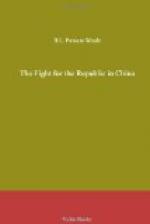“Disproportionate taxation on commodities at inland towns and cities tends to cripple the productive power of a country. Acting upon this principle, France in the 17th, England, America, Germany and Austria in the 18th Century abolished such kind of taxation, the Customs tariff remaining, which is a levy on imports at the first port of entry. Its purpose is to increase the cost of production of imported goods and to serve as a protection of native products (sic). Raw materials from abroad are, however, exempt from Customs duty in order to provide cheap material for home manufactures. An altogether different state of affairs, however, exists in this country. Likin stations are found throughout the country, while raw materials are taxed. Take the Hangchow silk for instance. When transported to the Capital for sale, it has to pay a tax on raw material of 18 per cent. Foreign imported goods on the other hand, are only taxed at the rate of five per cent, ad valorem Customs duty at the first port of entry with another 2.5 per cent, transit duty at one of the other ports through which the goods pass. Besides these only landing duty is imposed upon imported goods at the port of destination. Upon timber being shipped from Fengtien and Antung to Peking, it has to pay duties at five different places, the total amount of which aggregates 20 per cent, of its market value, while timber from American is taxed only ten per cent. Timber from Jueichow to Hankow and Shanghai is taxed at six different places, the total amount of duty paid aggregating 17.5 per cent., while timber imported from abroad to these ports is required to pay Customs duty only one-third thereof. The above-mentioned rates on native goods are the minimum. Not every merchant can, however, obtain such special “exemption,” without a long negotiation and special arrangements with the authorities. Otherwise, a merchant must pay 25 per cent, of the market value of his goods as duty. For this reason the import of timber into this country has greatly increased within the last few years, the total amount of which being valued at $13,000,000 a year. Is this not a great injustice to native merchants?
THE CHINESE METHOD
“Respecting the improvement of the economic condition of the people, a country can hardly attain this object without developing its foreign commerce. The United States of America, Germany and Japan have one by one abolished their export duty as well as made appropriations for subsidies to encourage the export of certain kinds of commodities. We, on the other hand, impose likin all along the line upon native commodities destined for foreign market in addition to export duty. Goods for foreign market are more heavily taxed than for home consumption. Take the Chekiang silk for instance. Silk for export is more heavily taxed than that for home use. Different rates of taxation are imposed upon tea for foreign and home market. Other kinds of native products for export are also heavily taxed with the result that, within the last two decades, the annual exports of this country are exceeded by imports by over Tls. 640,000,000,000. From the 32nd year of the reign of Kuang Hsu to the 4th year of the Republic, imports exceed exports on the average by Tls. 120,000,000. These figures speak for themselves.




